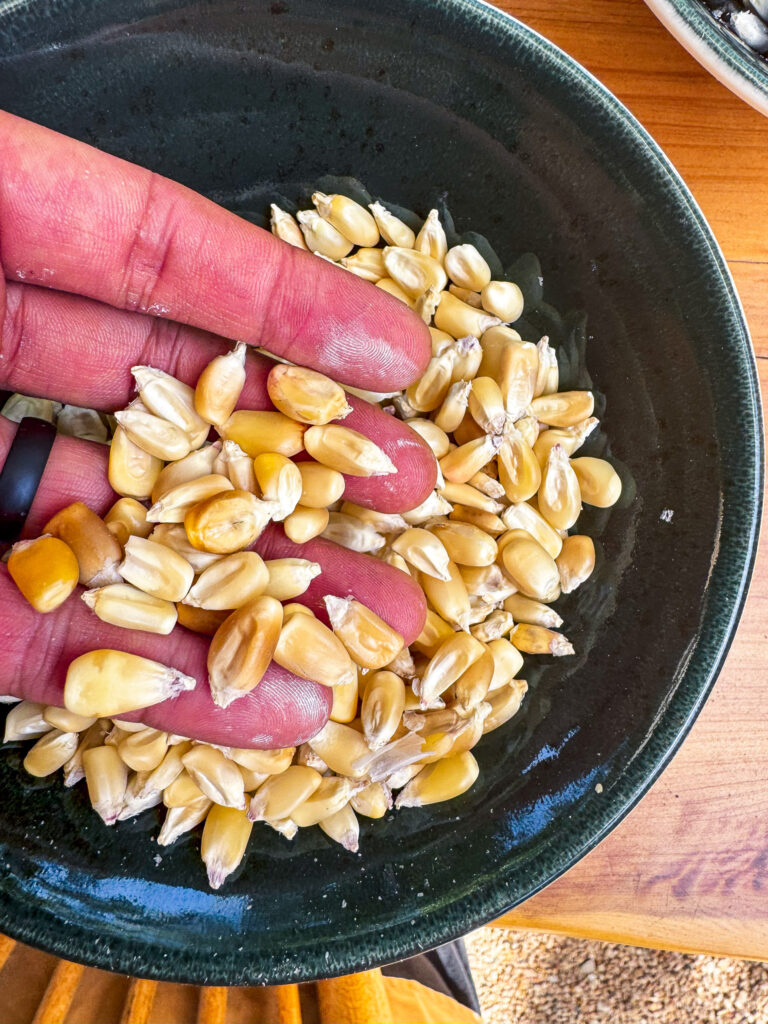
“And this was the beginning of the formation of the people. Yellow corn and white corn were the food. From these, they made the body and the flesh. Ground was the corn, and made drink of, nine times was it washed. Their flesh was of the yellow corn, their blood of the white corn. Thus was man created by the gods. And they gave them for food the small grains, called masoritas, and paternoster beans together with the maize.”
— Popol Vuh, Book IV
First, the gods tried making humans from mud, but they dissolved.
Then they tried making them from wood, but they were soulless and destroyed.
Finally, from maize dough mixed with water, the first true people were created.
This myth explains why the Maya see themselves as literally “the people of maize.”
White maize made their bones; yellow maize made their flesh.
Maize (Zea mays) is the foundational food and substance of humanity in the Maya culture.
The Popol Vuh is the Maya’s sacred book of creation and history. The Popol Vuh as we know it today was written down in the mid-16th century (around 1554–1555 CE) by an anonymous K’iche’ Maya nobleman.
It gives us a Maya perspective on the universe, creation, and the role of humans. It remains a living cultural text for the Maya people.

The Popol Vuh tells how the Hero Twins Hunahpú and Xbalanqué bring renewal through sacrifice and rebirth, and how their grandmother Xmucane grinds maize, allowing the gods to create the first true humans.
Together, the Twins, the grandmother, and the Corn embody the Maya understanding of life, death, rebirth, and the sacred bond between people and maize.
Today many modern Maya hang dried ears of maize in their homes as a reminder that the Maize is not just food, but a living being. Maize is an ancestor, and the essence of life itself and a reminder of the deep truth told in the Popol Vuh that human beings and maize share the same life force.
Even when dried, maize is “sleeping,” not dead, ready to awaken again, to sprout, feed, and regenerate in the cycle of life.
Handmade Corn Tortillas using Masa Harina
Ingredients
- 1 cup Masienda Heirloom Corn Masa Harina
- 1 cup warm water
- Salt and/or spices to taste (optional)
Equipment
- Tortilla Press
- Comal or Cast Iron Pan
- Medium mixing bowl
- Plastic Liner or ziplock bag cut into sheets
Directions
- Slowly add warm water to the dry masa flour in your bowl, stirring the masa to incorporate evenly by hand.
- Knead until the water is evenly incorporated and no dry, powdery spots remain. Tortilla masa should be moist to the touch, but not tacky (leaving bits of wet masa on your hand and fingers). If it’s too wet, add a bit more masa; if too dry, add a bit more water.
- Once masa is well combined, add optional salt and/or spices to taste, evenly incorporating throughout finished masa.
- Heat Comal or nonstick skillet on the stove to low-medium heat.
- Roll masa into ping pong sized balls, placing them back into the bowl once rolled.
- Once all masa is rolled into balls, turn Comal or skillet up to medium/medium-high heat.
- Open tortilla press and place the first sheet of plastic down. Place one ball of masa on the plastic, and press down slightly to flatten. Add second piece of plastic on top of the masa ball. Close the tortilla press, applying pressure to flatten the dough, aiming for a tortilla 1/16″ thick.
- Open press, removing the top sheet of plastic and placing the uncooked tortilla on your palm before removing the second piece.
- Gently lay the tortilla on the hot Comal or Pan (no oil is required), searing for 20-30 seconds on the first side. Flip the tortilla to allow the other side to sear for the same amount of time. One last flip, to land back on the first side, is where the tortilla will finish and where you may see the elusive tortilla puff! Continue cooking all tortillas.
- Store tortillas in a clean dish towel once cooked, which will allow them to steam and soften slightly. Serve immediately.
